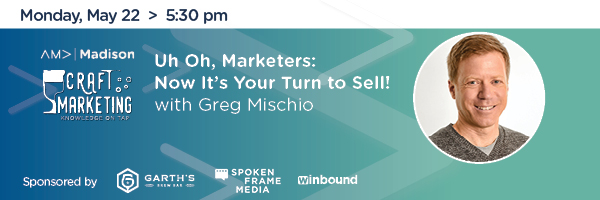Marketers are feeling more pressured than ever to produce huge results. This challenge is nothing new for sales professionals, but for marketers, it’s new terrain.
How did we get here? Gartner research has shown that today’s customers are 57% through the purchase process before they reach their first meaningful contact with a sales person.
To get leads to this point in the buyer’s journey, marketing has to step up to the selling plate. But to most marketers, the idea of selling is nothing short of intimidating.
But there’s no need to panic: Greg Mischio, Owner and Founder of Winbound, spilled the three strategies marketers can lean on to sell successfully at AMA’s Craft Marketing event on May 22nd.
Greg opened with a classic sales mantra:
“People will only do business with you if they know you, like you, and trust you.”
In other words, it’s to your advantage to base your selling strategy on human behavior. As Greg put it, no matter what the next big thing in marketing ends up being, you’ll always find success if you master all three of these core strategies. Read on to get Greg’s advice on how to do just that.
How to Master Selling as a Marketer in 3 Core Strategies
1. Know You
Before anything else, you need to capture your audience’s attention. Many marketers get so wrapped up in showcasing the benefits of their products and services that they fail to acknowledge the dilemmas and fears that their audiences face. But the reality is that people make decisions based on emotion. That’s why focusing on common pain points is so powerful.
For example, saying, “Our product can save you 50%” is far less attention-grabbing than “We can prevent you from losing 50% of your profit.” The latter acknowledges and offers a solution to a very real fear that people have. As a result, it’s far more likely to resonate with them and even more, make them feel something.
Greg pointed out that in this pursuit, your biggest competition is the fear of change. To come out ahead, it’s up to you to convince them that the pain of the status quo is worse than the pain of adopting your solution. He added that while it’s fine to hint at your solution in your messaging, it’s best to focus on the pain points.
2. Like You
After you’ve appealed to your audience’s pain points, you can start selling them on your product. But you have to be smooth about it – most people don’t want to feel like they’re actively being sold to.
According to Gartner, the most effective sales person is the challenger. This type of sales person isn’t pushy. Instead, they provide valuable insights that introduce the potential customer to new, better ways of doing things that improves their pain points. This technique is called the reframe.
Greg gave the example of a company that was trying to sell color copy machines to a school district. They learned that the district was struggling with low test scores, and found research that showed that colors help kids retain knowledge. Presenting that insight to the school district officials made a world of a difference and the company was able to close its deal.
As a marketer, you can tackle the reframe by asking your sales team what your prospects’ biggest pain points are. Then, you can craft targeted messaging that actually resonates with your audience and avoid scaring them away with an “in your face” selling approach.
3. Trust You
Finally, you need to earn your audience’s trust. Greg offered 3 tips to help you get there:
✔️Put your prices or pricing structure on your website for all to see. This transparency will go a long way in building your audience’s trust. Even if you’re only able to walk the customer through your typical buying process, this can be a big hit among prospects.
✔️Capture case studies in video form as well as print. Sure, not everyone is comfortable on camera, but it’s worth pursuing, as hearing from experienced customers is a more powerful trust builder than simply reading their quotes.
✔️Ask your sales team for frequently asked questions. There may be some common concerns or curiosities you can satisfy, whether it’s answering them on a FAQ page on your website or creating a whitepaper breaking down the topic.
Want More Marketing Insights & Community?
While Craft Marketing will be on a summer break until September, AMA has plenty of exciting events coming up that will be announced soon. Be sure to follow us on LinkedIn, Facebook, and Twitter for regular updates, and check out our events page for more news to come.
Thanks to our sponsors:
About the Author
Kara Martin, Content Writer at Naviant, specializes in written B2B content, from case studies to blogs and beyond. She transforms complex technical information into compelling, data-driven content that helps organizations turn their digital transformation goals into a reality.




